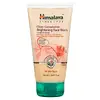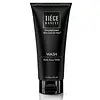What's inside
What's inside
 Key Ingredients
Key Ingredients

No key ingredients
 Benefits
Benefits

 Concerns
Concerns

 Ingredients Side-by-side
Ingredients Side-by-side

Water
Skin ConditioningAmmonium Lauryl Sulfate
CleansingCocamidopropyl Betaine
CleansingGlycol Distearate
EmollientSodium Cocoyl Glutamate
CleansingDisodium Cocoyl Glutamate
CleansingCoco-Glucoside
CleansingGlycerin
HumectantAcrylates/C10-30 Alkyl Acrylate Crosspolymer
Emulsion StabilisingPEG-150 Distearate
EmulsifyingCetyl Alcohol
EmollientGlyceryl Oleate
EmollientParfum
MaskingPhenoxyethanol
PreservativeSodium Hydroxide
BufferingCrocus Sativus Flower Extract
MaskingCucumis Sativus Fruit Extract
EmollientCitric Acid
BufferingMenthyl Lactate
MaskingMethylchloroisothiazolinone
PreservativeMethylisothiazolinone
PreservativeDisodium EDTA
Tocopheryl Acetate
AntioxidantPunica Granatum Fruit Extract
AntioxidantMenthol
MaskingGlycyrrhiza Glabra Root Extract
BleachingCI 15985
Cosmetic ColorantWater, Ammonium Lauryl Sulfate, Cocamidopropyl Betaine, Glycol Distearate, Sodium Cocoyl Glutamate, Disodium Cocoyl Glutamate, Coco-Glucoside, Glycerin, Acrylates/C10-30 Alkyl Acrylate Crosspolymer, PEG-150 Distearate, Cetyl Alcohol, Glyceryl Oleate, Parfum, Phenoxyethanol, Sodium Hydroxide, Crocus Sativus Flower Extract, Cucumis Sativus Fruit Extract, Citric Acid, Menthyl Lactate, Methylchloroisothiazolinone, Methylisothiazolinone, Disodium EDTA, Tocopheryl Acetate, Punica Granatum Fruit Extract, Menthol, Glycyrrhiza Glabra Root Extract, CI 15985
Water
Skin ConditioningAmmonium Lauryl Sulfate
CleansingDisodium Cocoamphodipropionate
CleansingCoconut Oil Aminoethoxyethanol Amides
FoamingC32-36 Isoalkyl Stearate
EmollientGlycol Distearate
EmollientGlycerin
HumectantCetearyl Alcohol
EmollientPolysorbate 60
EmulsifyingSodium Chloride
MaskingPhenoxyethanol
PreservativeCaprylyl Glycol
EmollientSalix Alba Bark Extract
AstringentCucumis Sativus Fruit Extract
EmollientCitric Acid
BufferingAcrylates/C10-30 Alkyl Acrylate Crosspolymer
Emulsion StabilisingLavandula Hybrida Oil
EmollientEucalyptus Globulus Leaf Oil
PerfumingWater, Ammonium Lauryl Sulfate, Disodium Cocoamphodipropionate, Coconut Oil Aminoethoxyethanol Amides, C32-36 Isoalkyl Stearate, Glycol Distearate, Glycerin, Cetearyl Alcohol, Polysorbate 60, Sodium Chloride, Phenoxyethanol, Caprylyl Glycol, Salix Alba Bark Extract, Cucumis Sativus Fruit Extract, Citric Acid, Acrylates/C10-30 Alkyl Acrylate Crosspolymer, Lavandula Hybrida Oil, Eucalyptus Globulus Leaf Oil
Ingredients Explained
These ingredients are found in both products.
Ingredients higher up in an ingredient list are typically present in a larger amount.
Acrylates/C10-30 Alkyl Acrylate Crosspolymer is a synthetic polymer. It is used to thicken and improve the texture of products. Due to its properties, it can prevent water and oil ingredients from separating.
Ammonium Lauryl Sulfate is a type of sulfate. It can be bad for dry skin, be bad for oily skin, and cause irritation.
Citric Acid is an alpha hydroxy acid (AHA) naturally found in citrus fruits like oranges, lemons, and limes.
Like other AHAs, citric acid can exfoliate skin by breaking down the bonds that hold dead skin cells together. This helps reveal smoother and brighter skin underneath.
However, this exfoliating effect only happens at high concentrations (20%) which can be hard to find in cosmetic products.
Due to this, citric acid is usually included in small amounts as a pH adjuster. This helps keep products slightly more acidic and compatible with skin's natural pH.
In skincare formulas, citric acid can:
While it can provide some skin benefits, research shows lactic acid and glycolic acid are generally more effective and less irritating exfoliants.
Most citric acid used in skincare today is made by fermenting sugars (usually from molasses). This synthetic version is identical to the natural citrus form but easier to stabilize and use in formulations.
Read more about some other popular AHA's here:
Learn more about Citric AcidThis extract comes from cucumber. Cucumbers are mostly made up of water (95%), and the other 5% is composed of: vitamin C, caffeic acid, fatty acids, amino acids, and other minerals.
Cucumbers have anti-inflammatory, barrier repair, and hydrating properties.
They contain shikimate dehydrigenase, an enzyme shown to help reduce inflammation and soothe the skin.
The amino acids found in cucumbers help nourish our skin's natural acid mantle (it's an important part of our skin barrier). This slightly acidic film acts as a barrier to protect us from bacteria, viruses, and other contaminants.
Unless you have an allergy to cucumbers, this is generally a non-irritating ingredient.
Fun fact: Cucumis Sativus is native to South Asia and can now be found on every continent.
Learn more about Cucumis Sativus Fruit ExtractGlycerin is already naturally found in your skin. It helps moisturize and protect your skin.
A study from 2016 found glycerin to be more effective as a humectant than AHAs and hyaluronic acid.
As a humectant, it helps the skin stay hydrated by pulling moisture to your skin. The low molecular weight of glycerin allows it to pull moisture into the deeper layers of your skin.
Hydrated skin improves your skin barrier; Your skin barrier helps protect against irritants and bacteria.
Glycerin has also been found to have antimicrobial and antiviral properties. Due to these properties, glycerin is often used in wound and burn treatments.
In cosmetics, glycerin is usually derived from plants such as soybean or palm. However, it can also be sourced from animals, such as tallow or animal fat.
This ingredient is organic, colorless, odorless, and non-toxic.
Glycerin is the name for this ingredient in American English. British English uses Glycerol/Glycerine.
Learn more about GlycerinGlycol Distearate serves as a pearlizing or opacifying agent in cosmetic products.
It's often included in cleansers and haircare products to give them a lustrous or shimmering appearance.
It is derived from stearic acid, a natural fatty acid commonly found in vegetable oils and animal fats.
Glycol Distearate isn't fungal acne safe.
Learn more about Glycol DistearatePhenoxyethanol is a preservative that has germicide, antimicrobial, and aromatic properties. Studies show that phenoxyethanol can prevent microbial growth. By itself, it has a scent that is similar to that of a rose.
It's often used in formulations along with Caprylyl Glycol to preserve the shelf life of products.
Water. It's the most common cosmetic ingredient of all. You'll usually see it at the top of ingredient lists, meaning that it makes up the largest part of the product.
So why is it so popular? Water most often acts as a solvent - this means that it helps dissolve other ingredients into the formulation.
You'll also recognize water as that liquid we all need to stay alive. If you see this, drink a glass of water. Stay hydrated!
Learn more about Water